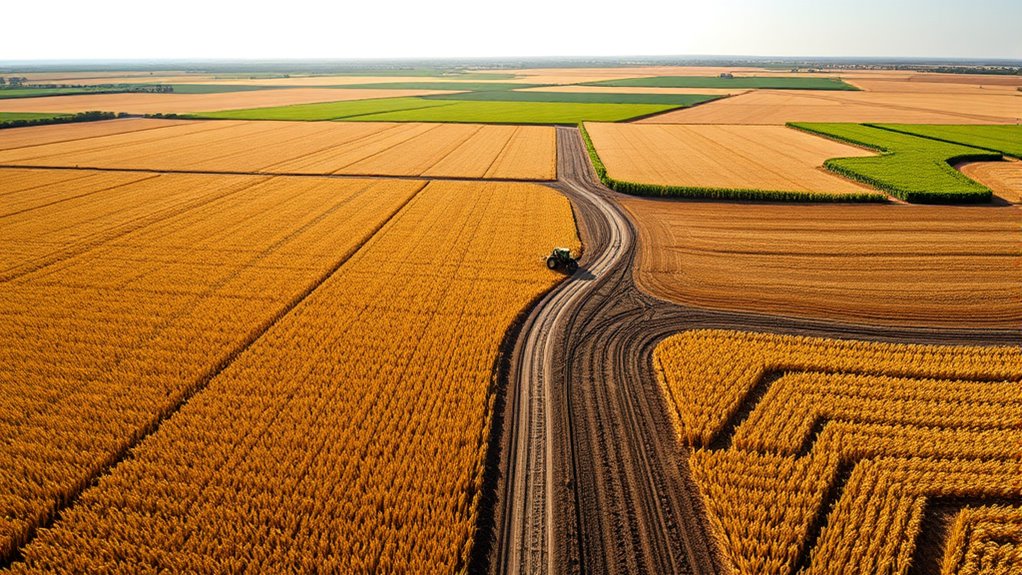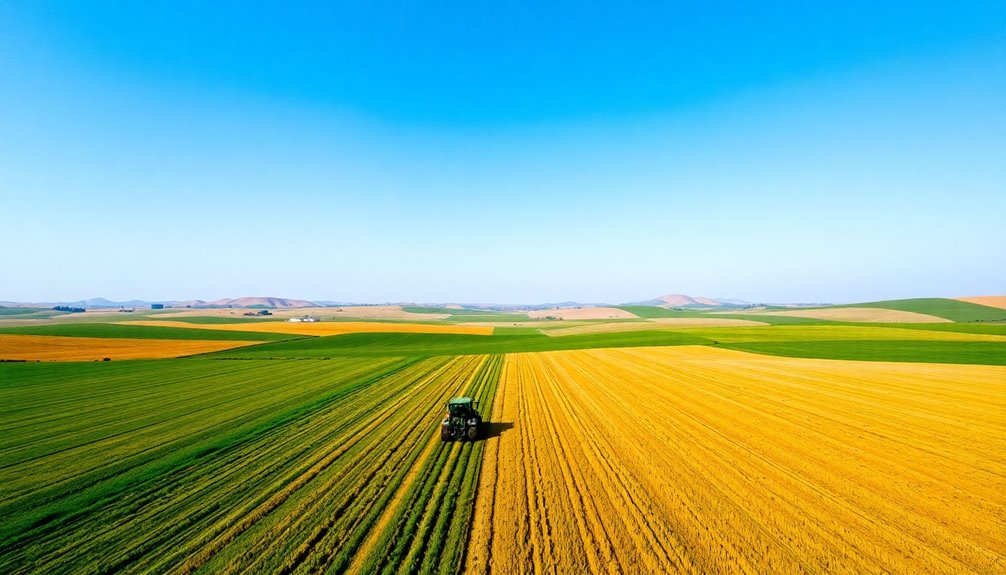Extensive agriculture is a farming method that uses large land areas with minimal inputs, relying heavily on natural resources like rainfall and soil fertility. It's common in regions such as the Murray-Darling Basin in Australia and parts of Texas, Africa, and South America. This approach typically results in lower yields and input costs. If you want to explore more about its environmental impacts, practices, and challenges, there's plenty more to discover.
Key Takeaways
- Extensive agriculture involves large land areas with minimal inputs, relying on natural resources like rainfall and soil fertility.
- Common in mid-latitude regions, it includes areas like the Murray-Darling Basin in Australia and parts of Texas, Africa, Asia, and South America.
- This farming method typically yields lower crop densities but can produce higher prices due to organic perceptions and lower input costs.
- It enhances biodiversity by promoting crop and livestock diversity, utilizing agroforestry, and maintaining natural ecosystems within agricultural landscapes.
- Practices such as crop rotation, efficient water management, and livestock grazing are essential for maintaining soil health and adapting to climate changes.
What Is Extensive Agriculture?
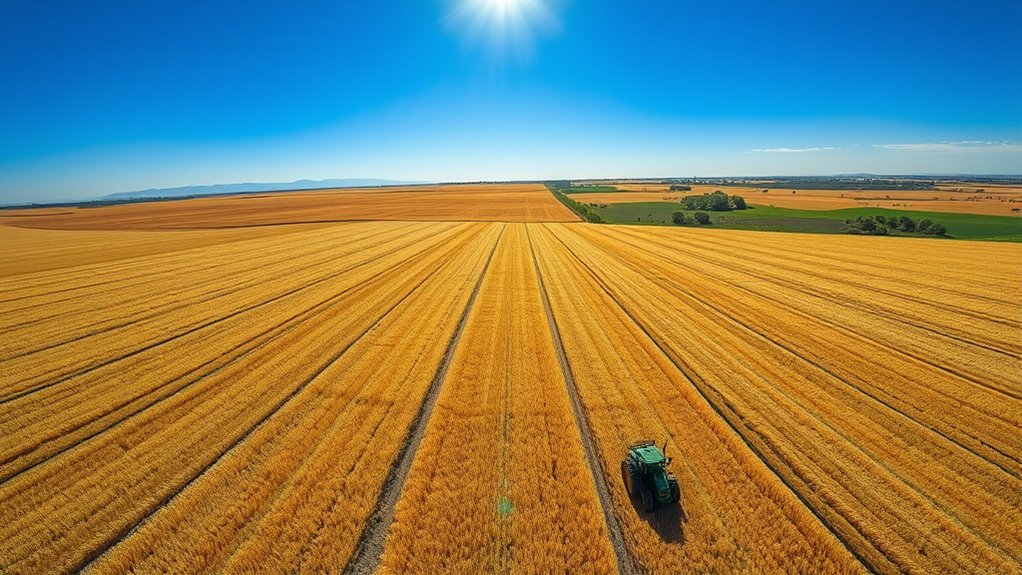
Extensive agriculture, often likened to a vast canvas of natural resources, involves farming practices that cover large land areas with minimal inputs. This method emphasizes the use of natural resources, relying on rainfall and soil fertility rather than artificial irrigation or chemical fertilizers.
You'll notice that extensive agriculture typically features lower crop densities and yields compared to intensive farming. It's often practiced in regions where land is abundant but labor is limited.
Geographic Distribution of Extensive Agriculture
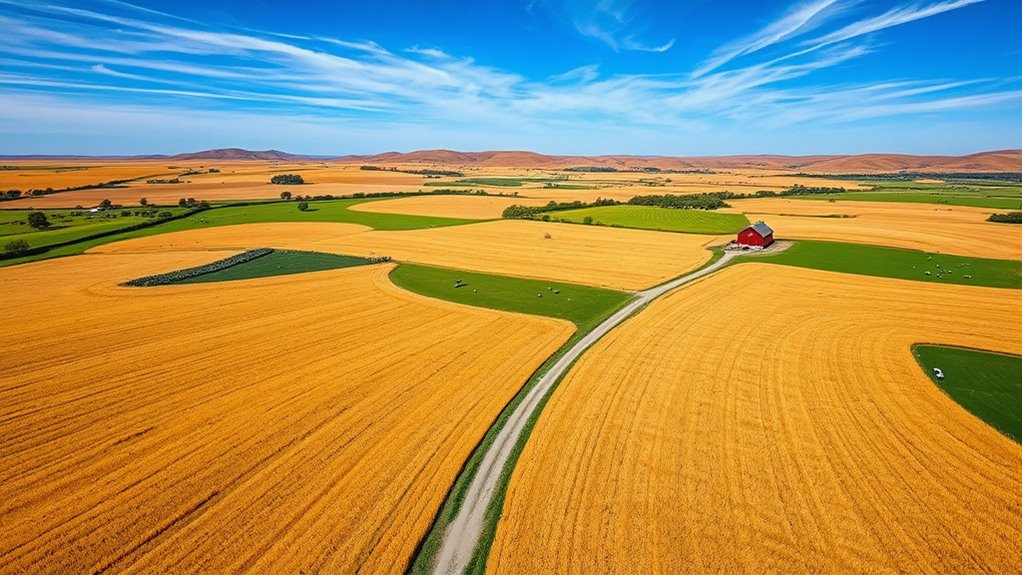
Farming practices that utilize extensive agriculture are spread across various geographic regions, particularly in mid-latitude areas of most continents.
Extensive agriculture thrives in mid-latitude regions, adapting to diverse geographic conditions across continents.
You'll find extensive farming in desert regions where water is scarce, as well as in vast, low-density areas. For instance, the Murray-Darling Basin in Australia is known for large-scale grain crops like wheat and barley.
This method thrives in climates with natural soil fertility and lower rainfall, making it ideal for drier regions. Extensive agriculture often involves grazing livestock on native grasslands, enhancing animal welfare.
You can see this approach in places like Texas and across parts of Africa, Asia, and South America, where the practice adapts to local conditions while contributing significantly to agricultural economies.
Environmental Impact of Extensive Agriculture
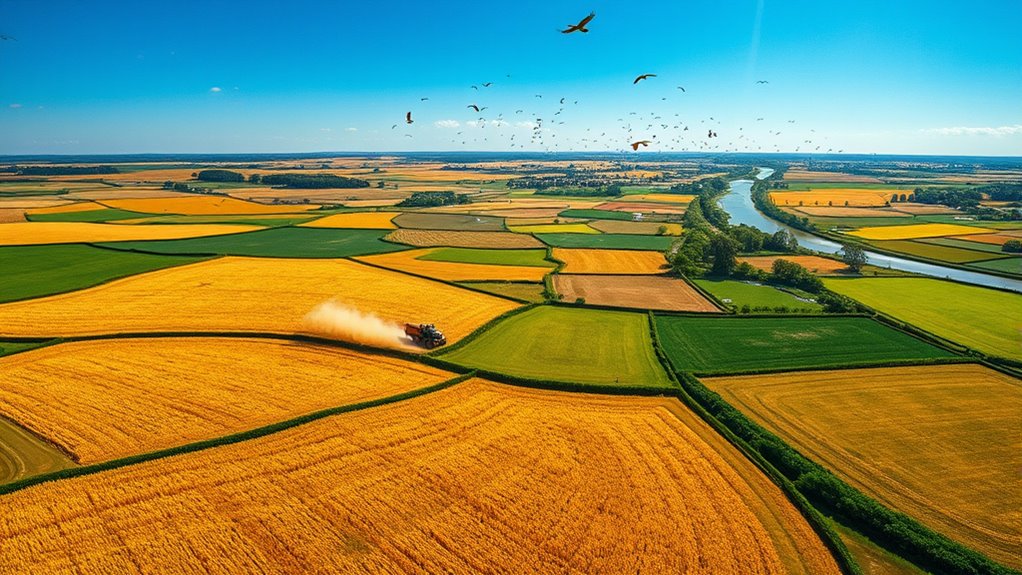
While many people associate agriculture with intensive practices that often harm the environment, extensive agriculture offers a more sustainable alternative. This method typically has a lower ecological impact due to reduced chemical and machinery use. However, it requires large land areas, which can limit habitats for wildlife.
When managed sustainably, extensive farming can preserve natural ecosystems and maintain soil health through minimal fertilizer use. It relies on natural rainfall, consuming less water and promoting soil carbon sequestration.
Though methane emissions from livestock are a concern, extensive systems can support biodiversity and provide essential ecosystem services. By using local forage and native breeds, extensive agriculture helps maintain genetic diversity, paving the way for a healthier environment.
Economic Aspects of Extensive Agriculture

Although many often overlook extensive agriculture, its economic aspects reveal a viable alternative to intensive methods.
You'll find that extensive farming typically incurs lower input costs, needing less capital and fewer resources like labor and fertilizers. This cost-effectiveness shines, especially in areas lacking expensive technologies.
Moreover, products from extensive agriculture often fetch higher prices due to their perceived organic qualities, offering market opportunities. By relying on local resources, this approach can also be more resilient to market fluctuations.
While it may face challenges like lower profitability and income gaps, extensive agriculture supports rural economic growth by creating diverse job opportunities, making it a valuable option for sustainable livelihoods.
Common Practices in Extensive Agriculture
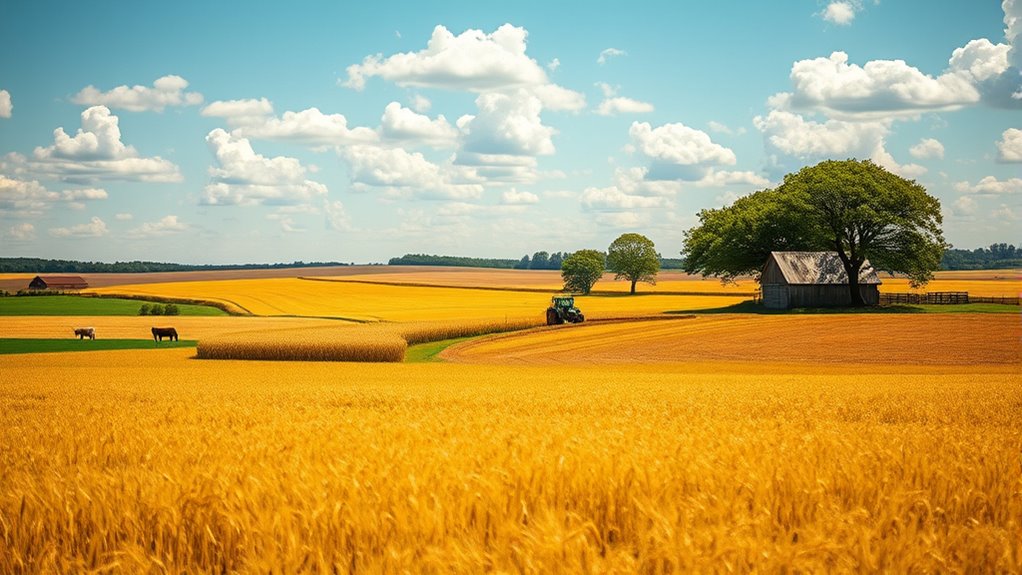
Extensive agriculture employs various practices that prioritize sustainability and ecological balance.
You'll often find large areas of land being used with minimal labor and capital inputs, especially in regions like North America and Australia.
Maintaining natural fertility is essential, which is why crop rotation and diversity are crucial. By rotating crops, you help preserve soil health and reduce pest risks without heavy chemical use.
In livestock systems, animals graze over vast areas, contributing to soil fertility and maintaining grassland health. This method relies on fewer technological inputs and emphasizes local resources, aligning traditional knowledge with modern practices.
Examples of Extensive Agriculture Around the World
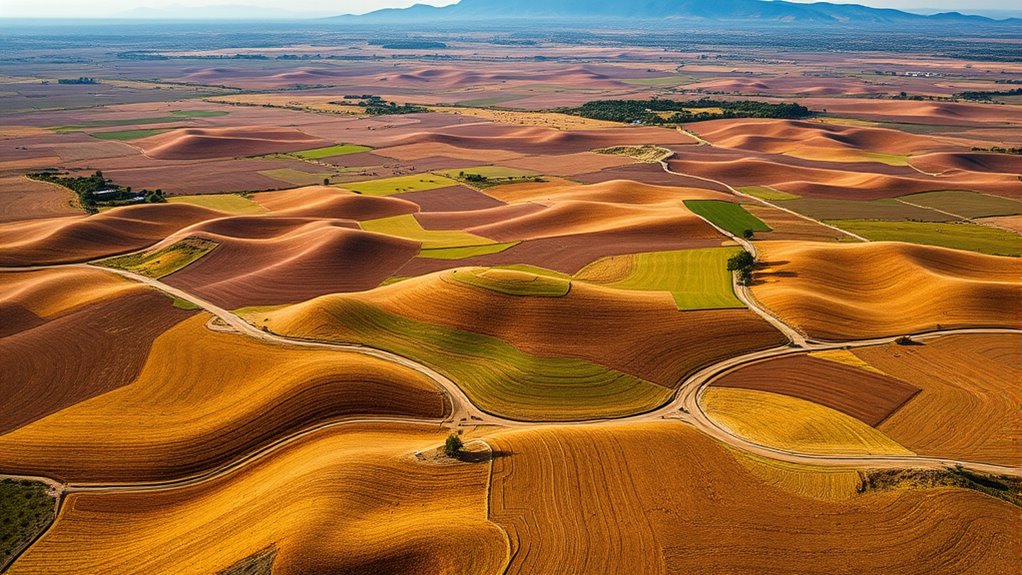
Around the globe, extensive agriculture takes many forms, tailored to local climates and resources.
In Argentina, you'll find extensive farming in the Pampas, focusing on crops like wheat, maize, and soybeans.
Australia's Downs region is known for large-scale livestock grazing and crop production.
In Canada, the Prairies thrive with wheat and canola, while Russia's Steppes support vast wheat fields.
The Great Plains in the United States are famous for extensive practices, especially in wheat and corn.
Over in South Africa, the Veld region emphasizes livestock and crops suited to local conditions.
Ukraine's Steppes are also significant for grain production, showcasing how extensive agriculture adapts to each unique environment.
Nomadic Herding as a Form of Extensive Agriculture
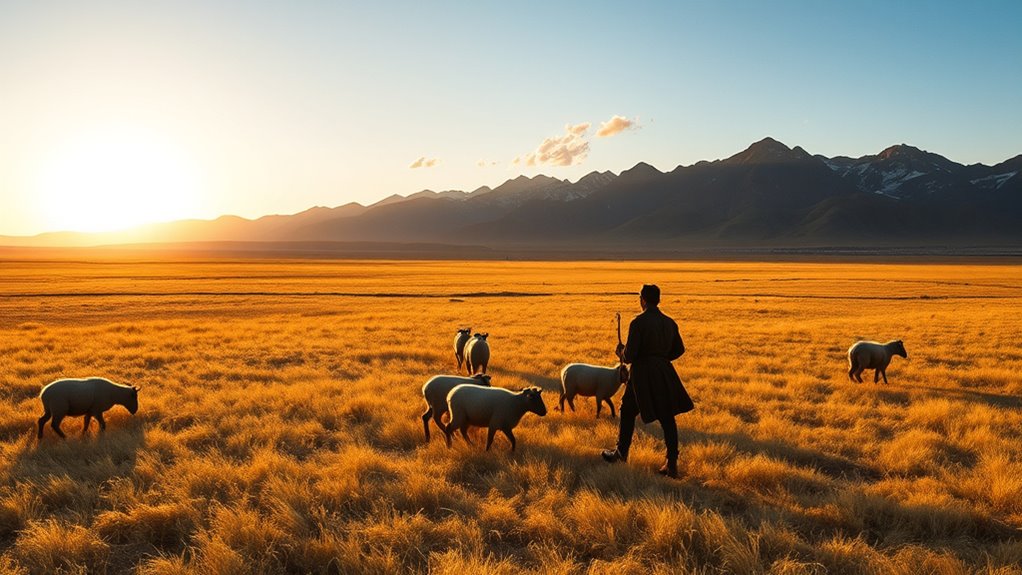
While many agricultural practices focus on cultivating crops, nomadic herding stands out as a unique form of extensive agriculture that thrives in arid and semi-arid regions.
In this practice, you move livestock like cattle, sheep, and goats to find fresh pastures, adapting to the limited arable land available. Common in the Sahel region and Central Asia, nomadic herding requires minimal labor and capital compared to intensive farming.
You'll find it among communities such as the Fulani and Tuareg in Africa and the Bedouins in the Middle East. This lifestyle promotes trade with sedentary farmers, exchanging meat for grains, and often supports a more egalitarian social structure, reflecting the unique demands and benefits of pastoral living.
Challenges Faced by Extensive Agriculture
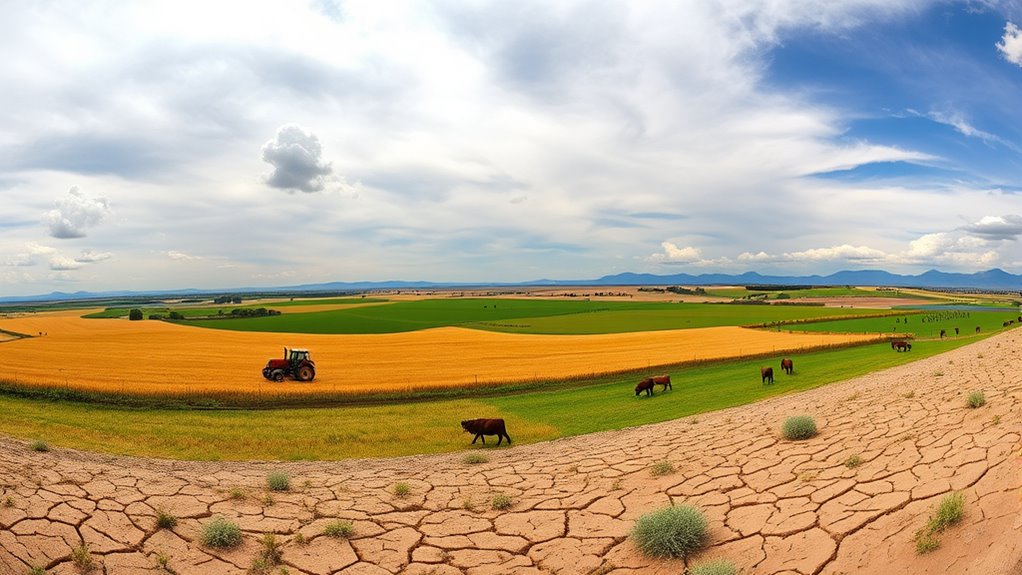
As agricultural practices evolve, numerous challenges confront extensive agriculture that can impact its viability.
You'll face land use issues, especially in densely populated areas, making it tough to secure enough space. Water management becomes crucial since extensive farming relies on natural sources, while adapting to climate change is essential for future success.
Economically, you might struggle against intensive farming competitors, experiencing income instability and limited market access.
Technologically, the lack of advanced tools makes efficiency improvements challenging.
Socially, labor availability could diminish local job opportunities.
Lastly, maintaining long-term sustainability while balancing environmental impact and resource management requires ongoing effort.
Addressing these challenges is essential for the future of extensive agriculture.
The Role of Extensive Agriculture in Food Security

Extensive agriculture plays a vital role in food security by providing diverse food sources that enhance nutritional access for communities. By utilizing large areas of land with minimal inputs, it supports local food production through varied crops and livestock integration.
This method helps ensure a stable food supply, maintaining affordability and availability for all. You'll find that extensive agriculture promotes resilience against market fluctuations, reducing dependency on external resources.
It also supports rural communities, fostering economic stability and preserving cultural practices. Moreover, its lower environmental impact and focus on sustainability protect natural resources, making it a crucial component in achieving long-term food security while promoting healthier ecosystems.
Future of Extensive Agriculture in a Changing Climate

Given the challenges posed by climate change, the future of extensive agriculture hinges on its ability to adapt and thrive in a shifting environment. Rising temperatures and altered rainfall patterns can significantly impact your crop yields, making adaptation crucial.
You might consider implementing crop rotation and using natural fertilizers to maintain soil health and boost productivity. Additionally, developing climate-resilient crop varieties will help stabilize yields under changing conditions.
Integrating agroforestry practices can enhance biodiversity while improving soil quality. Efficient water management strategies are essential as water scarcity becomes a pressing issue.
Frequently Asked Questions
How Does Extensive Agriculture Compare to Intensive Agriculture in Practice?
When you compare extensive agriculture to intensive agriculture in practice, you'll notice that extensive farming uses large tracts of land with minimal labor and capital inputs, relying on natural resources.
In contrast, intensive farming focuses on smaller areas, maximizing yields through high labor and technology.
While extensive agriculture promotes ecological diversity and lower environmental impact, intensive methods can lead to soil degradation and pollution due to their heavy reliance on chemicals and advanced inputs.
What Crops Are Typically Grown in Extensive Agricultural Systems?
Ever wondered what crops thrive on vast expanses of land? In extensive agricultural systems, you'll typically find wheat, maize, and millets flourishing.
These hardy crops adapt well to large-scale cultivation, making them favorites among farmers. Cotton also makes an appearance, particularly in spacious areas.
With ample land available, these crops benefit from mechanized processes that enhance production, allowing you to see high yields despite lower intensity farming methods.
How Does Extensive Agriculture Impact Local Economies?
Extensive agriculture impacts local economies by creating job opportunities in related sectors like livestock management and crop handling, even though it generally offers lower economic returns per unit of land.
You'll see benefits in regions with abundant land, where lower input costs can boost farmers' profitability.
However, the overall contribution to the local economy often lags behind that of intensive agriculture, largely due to lower yields per hectare.
What Are the Main Challenges for Farmers Practicing Extensive Agriculture?
You might think farming's all about abundance, but extensive agriculture faces significant challenges.
You'll struggle with lower yields and market competition, making profitability tough. Reliance on natural factors means your success can be unpredictable, while limited access to technology can hinder efficiency.
Plus, you'll notice the impact of environmental issues like soil health and water availability, which can complicate your farming efforts. Engaging your community and adapting to these challenges is essential for sustainability.
How Can Technology Improve Extensive Agricultural Methods?
Technology can significantly enhance your extensive agricultural methods.
By using precision farming tools like remote sensing and GPS, you can monitor crop health and optimize resource use.
Automation, such as autonomous tractors and robotic harvesting, reduces labor costs and increases efficiency.
Implementing IoT devices allows for real-time monitoring, and data analytics helps you make informed decisions.
These innovations not only boost productivity but also promote sustainability in your farming practices.
Conclusion
In conclusion, extensive agriculture plays a crucial role in our food systems, especially as we face climate change. While it may seem less intensive, this approach can support sustainable practices and biodiversity. You might think that modern farming is the only way forward, but extensive methods like nomadic herding remind us of the balance we can achieve with nature. By embracing this age-old practice, we can ensure a resilient future for food security and the environment.

